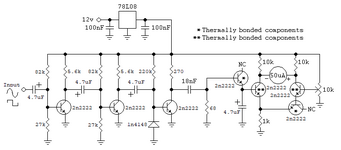neazoi
Advanced Member level 6
I did not thermally bonded them I just blew air onto both of them. Ok I will do so. Isn't a balance pot needed at the emitters? Or is it taken care of from the other pot in the input of one of the two transistors?Try linking the emitters together and grounding them through a single resistor (try 1K). The transistors MUST be thermally bonded so any change in temperature has the same effect on both.
Brian.
